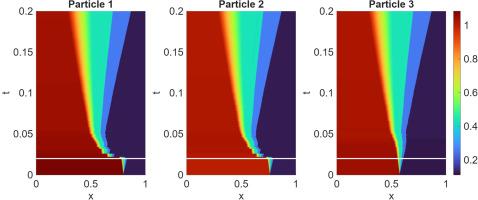通过特征对齐保持特征的数据同化
IF 7.3
1区 工程技术
Q1 ENGINEERING, MULTIDISCIPLINARY
Computer Methods in Applied Mechanics and Engineering
Pub Date : 2025-09-02
DOI:10.1016/j.cma.2025.118345
引用次数: 0
摘要
数据同化结合了来自物理观测和数值模拟结果的信息,以获得对物理系统状态和参数的更好估计。许多令人感兴趣的物理系统都有解,它们表现出结构的形成,称为特征,这些结构必须被同化框架准确地捕获。例如,流体会产生冲击波和接触不连续等特征,这些特征需要在数据同化过程中进行跟踪和保存。最先进的数据同化技术对这些特征是不可知的。当前基于集成的方法通过对多个集成状态进行线性组合来构造状态估计;重复平均往往会在多个同化周期中涂抹特征,导致非物理状态估计。为了克服现有同化算法的局限性,提出了一种将序列对齐与集合变换粒子滤波相结合的保持特征的数据同化方法。具体来说,粒子的最佳传输是沿着特征对齐的特征进行的。在可压缩欧拉方程描述的多个测试问题上证明了所提出的特征保持滤波方法的强度。本文章由计算机程序翻译,如有差异,请以英文原文为准。

Feature preserving data assimilation via feature alignment
Data assimilation combines information from physical observations and numerical simulation results to obtain better estimates of the state and parameters of a physical system. A wide class of physical systems of interest have solutions that exhibit the formation of structures, called features, that have to be accurately captured by the assimilation framework. For example, fluids can develop features such as shock waves and contact discontinuities that need to be tracked and preserved during data assimilation. State-of-the-art data assimilation techniques are agnostic of such features. Current ensemble-based methods construct state estimates by taking linear combinations of multiple ensemble states; repeated averaging tends to smear the features over multiple assimilation cycles, leading to nonphysical state estimates. A novel feature-preserving data assimilation methodology that combines sequence alignment with the ensemble transform particle filter is proposed to overcome this limitation of existing assimilation algorithms. Specifically, optimal transport of particles is performed along feature-aligned characteristics. The strength of the proposed feature-preserving filtering approach is demonstrated on multiple test problems described by the compressible Euler equations.
求助全文
通过发布文献求助,成功后即可免费获取论文全文。
去求助
来源期刊
CiteScore
12.70
自引率
15.30%
发文量
719
审稿时长
44 days
期刊介绍:
Computer Methods in Applied Mechanics and Engineering stands as a cornerstone in the realm of computational science and engineering. With a history spanning over five decades, the journal has been a key platform for disseminating papers on advanced mathematical modeling and numerical solutions. Interdisciplinary in nature, these contributions encompass mechanics, mathematics, computer science, and various scientific disciplines. The journal welcomes a broad range of computational methods addressing the simulation, analysis, and design of complex physical problems, making it a vital resource for researchers in the field.

 求助内容:
求助内容: 应助结果提醒方式:
应助结果提醒方式:


